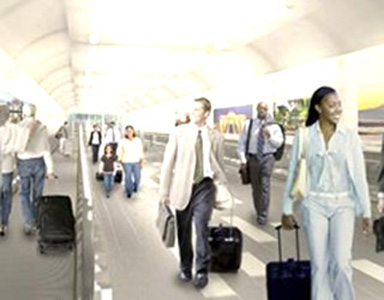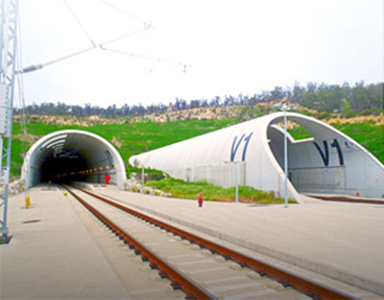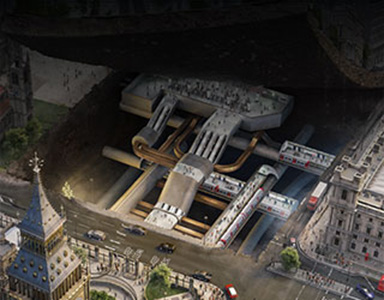English website
For hundreds of thousands of years, our natural domain has been a principally two-dimensional space : the surface of the ground.
Urged by necessity, curiosity, and even by temerity, we have always tried to escape from this space, either by widening it, which is only possible in a very restrictive sense, or by searching to utilize the third dimension, upwards or downwards. In these efforts, we have always encountered great difficulties that have been overcome thanks only to an astonishing tenacity.
Read moreHide
So it has been and so it still is in the conquest of the continents, the oceans, or outerspace. So it is for the use of underground space.
In this field, as in the others, nature provides many challenges and we must doggedly gather our experiences, draw lessons from failures, improve techniques and use all our resources of inventiveness before succeeding.
Underground works have always been difficult but this did not prevent their use at a very early stage of human development, as proved by the discovery of underground excavations that are among the first records of human activity.
Of course, nature, and not mankind, is at the origin of the first underground works. Grottos and caves are the result of the action of the rain, the rivers and the sea, and vital necessity drove early humans to settle in these natural cavities, no doubt to find protection from the weather and from attacks. On this point, it is tempting to think that humanity perhaps owes its survival largely to these natural habitats.
Cavemens' dwellings were an important landmark in the use of underground space by mankind ; with them, the use of the underground became intentional and active.
In every age, considerable use has been made of underground structures for mining and defensive purposes.
However, the most rapid increase in the use of underground works only appeared in the 19th and particularly the 20th centuries, thanks to the impetus of economic development.
During these periods, there was a dramatic increase in underground space use, in mining, in the field of transportation with the development of roads, waterways, and railways , and in the field of hydroelectric facilities.
So, since the dawn of human endeavor - more intensively during the recent centuries, and above all during the last decades - numerous reasons have encouraged mankind to use and develop underground space.
For a good understanding of these reasons, it is necessary to keep in mind certain fundamental characteristics of underground space.
- First, the underground medium is a space that can provide the setting for activities or infrastructures that are difficult, impossible, environmentally undesirable or less profitable to install above ground.
- Another fundamental characteristic of underground space lies in the natural protection it offers to whatever is placed underground. This protection is simultaneously mechanical, thermal, and acoustic.
- On the other hand, the containment created by underground structures has the advantage of protecting the surface environment from the risks and/or disturbances inherent in certain types of activities.
- Lastly, another important feature of underground space is its opacity. Thanks to the natural visual screen created by the geological medium, an underground structure is only visible at the point(s) where it connects to the surface.
But what are the main reasons today which justify a more intensive and a better-planned use of the underground space?
To Know more
ITA endorsed Publications
- Guidelines presented by the ITA WG 4 on Subsurface planning : To go underground Right or Wrong. ATTSU 1978
- Roundtable session on the subsurface use in developping countries. ATTSU 1982
Other Publications
Social reasons
Cities that are capable of functioning both in social and hygienic terms form the prerequisite for a decent life in built-up areas. Underground space has an important role to play in this respect, i.e. in the achievement of environmentally-friendly development, whether it be in the reduction of pollution or noise nuisance, the efficient use of space, economic development, the preservation of the living environment, public health or safety. In these fields, it offers numerous advantages.
- Tunnels play a vital environmental role by conveying clean water to and by conveying wastewater out from urban areas.
- Tunnels provide safe, environmentally sound, fast, and unobtrusive urban mass transit systems.
- City traffic tunnels clear vehicles from surface streets, traffic noise is reduced, air becomes less polluted and the surface street areas may partially be used for other purposes.
- Underground car parks and shopping malls in city centres leave room for recreation areas and playgrounds above ground.
- Multipurpose utility tunnels are less vulnerable to external conditions than surface installations and will cause only insignificant disturbance above ground when installed equipments are repaired or maintained.
Indirect benefits
The assessment of underground structures is strongly related to the community valuation of drawbacks of surface or aerial structures in terms of environmental degradation.
Read moreSocial balance
More and more, in a sustainable development aproach, the PIB is no longer the only value to take into account.
Read moreEnvironmental reasons
Land Use & location
That means mainly lack of surface place which is now the case not only in mega cities but in nearly all town and cities around the world.
Read moreIsolation considerations
The ground is massive and opaque and provides a variety of advantages in terms of isolation, such as climate, natural disasters and earthquake, protection, containment. Isolation is an important reason for placing facilities underground.
Read moreEnvironmental preservation
The ground also provides a variety of advantages in terms of protection of the environment, such as aesthetics or ecology. These are notably important aspects in designing facilities with a low environment impact.
Read moreTopographic reasons
In hilly or mountainous areas, the use of tunnels improves or make feasible various tranport options uch as roads, railways, canals, etc.
Read moreEconomical reasons
Economical aspects wrongly remain a major barrier to the development of the use of the underground space. Since the initial construction cost of underground structures is generally higher than those of building in the open air, underground structures are in a sense « penalized » when compared to open air construction on this restricted basis. Thus, the economical benefits of an underground facility should be calculated by estimating the life-cost impacts of the benefits provided by such a facility. Moreover, the assessment of the underground structures should take into account the various indirect advantages they offer, notably with regard to the environment.
Right from antiquity, men dug into the ground to find shelter, store their crops, carry water or for many other reasons.
«The earth sciences command a body of knowledge and an armoury of techniques which together allow the nature and quality of the ground to be predicted in general terms. The intelligent use of geotechnics can then provide an account of ground characteristics for optimal planning of the project and of its form of construction. There will be intermediate phases, yielding opportunities for further eploration and observation, for the more complex or inaccessible projects.»
(abstract from "Tunnelling Technologies for the 3rd Millennium", Foreword by Sir Alan Muir Wood, ITA-AITES President 1974-1977)
Design
Tunnel design is more than a determination of the structural adequacy of component parts - it must meet practical construction requirements to secure economy and safety in a range of ground conditions.
For this purpose multiple combined disciplines are required in the design of a tunnel or underground facility : geology, geotechnique, environmental sciences, soil and rock mechanics, structure calculations, electric engineering, aeraulics or hydraulics.
Another specifity of underground facilities is even though relations may be found between them, they can not be classified into prototypes or series. The construction of each facility is a remarkable adventure as it must be driven in a particular site featuring a rock mass in no way similar to any another.
Geology
In underground works, geology affects every major decision. Any underground infrastructure will need of excavation and ulterior support of the soil or rock mass where the infrastructure is to be built.
Read moreSite investigation
Geological and hydro-geological conditions are determining factors for underground structures, having a very deep impact on the planning and budget necessary to complete the project.
Read moreGeotechnics
Geotechnical studies and investigations are a complement to geology and hydrogeology. Their objectives are to know the basic characteristics of the ground which will have an impact on the mechanical behavior of the rock or soil, the initial state of equilibrium of the natural stresses.
Read moreDesign Methods
When an underground structure is built a redistribution of the natural initial stresses takes place. Due to this redistribution, the underground structure will be subjected to a certain level of stresses and hence loads.
Read moreGround treatment
When an underground structure is to be built and the conditions of the ground are far from ideal, there are different approaches that can be followed: designing a robust support to cope with the poor characteristics of the ground.
Read moreSupport Systems
In hilly or mountainous areas, the use of tunnels improves or make feasible various tranport options uch as roads, railways, canals, etc.
Read moreEnvironment
All environmental aspects have to be studied in order to knows the environmental impacts during the life cycle of an undeground space.
Read moreMonitoring
When designing underground structures there is a large amount of uncertainty due to a large number of factors.
Read moreConstruction Methods
Conventional Tunnelling
Conventional Tunnelling can be defined as the construction of underground openings of any shape with a cyclic construction process.
Read moreMechanised Tunnelling
As opposed to conventional techniques, these are all the tunneling techniques in which excavation is performed mechanically by means of teeth, picks or disks. These tunneling techniques comprise then a wide range of different machines
Read moreSurface Tunnelling
Surface tunnelling encompasses all construction methods of underground structures built by a temporary or permanent open trench in the surface.
Read moreSubaquatic Tunnelling
Immersed tunnels have been in widespread use for about 100 years. Over 150 have been constructed all over the world, about 100 of them for road or rail schemes.
Read moreCombination of Methods
A typical example of underground structure where a combination of methods is employed is a deep base transalpine tunnel, like Gotthard and Lotschberg tunnels in Switzerland.
Read moreOperation
Equipment
Installations and equipment are an important part of underground structures. They are complex, and usually comprise a quite large part of the general budget and planning of the whole structure.
Read moreAuscultation
Several factors influence the evolution of underground facilities from their opening. Basically, they are: age, material quality, construction method,and environment, characteristics of the traffic or fluids carried.
Read moreMaintenance
Due to the high value of tunnels a good maintenance scheme must be planned for all underground structures during its life of operation
Read moreRehabilitation
Rehabilitation of an underground structure could be described as its restoration to good condition, operation, or capacity.
Read moreSafety
Safety during design stage
Before any design or planning work begins, an occupational health and safety strategy for the project should be drawn up and set out in a health and safety plan.
Read moreSafety during construction stage
Training, equipment, safety signs, fire fighting, welfare, athmospheric monitoring, lighting.
Read moreFire Safety
Following several dramatic accidents in road tunnels, between 1999 and 2001. Tunnel safety became a concern, which led to a strong demand for improvements from tunnel users and politicians.
Read moreIncreasing competition for surface space, targets for energy savings and for the broader objectives of sustainable development, point progressively towards greater, more diverse and better coordinated use of the subsurface.
In this way, supply and demand both favour increase in the extent and range of use of the ground beneath our feet.
(Abstract from "Tunnelling Technologies for the 3rd Millennium" Foreword by Sir Alan MuirWood ITA president 1974-1977)
Dive into the deepest structure on earth!
Transport
Tunnels for transport exist for centuries.
They have been developped both in urban environment for mass transit transports and in interurban environment mainly to cross mountains both for roads and railways.
The development of transport tunnel is still very active, notably in mass transit specifically in Asian countries, but also in European countries where new techniques both concerning construction and exploitation allow smaller towns to build a metro network.
In interurban environment, long base tunnels trend to replace summit tunnels and many underwater tunnels have been built or are at a project stage.
Urban Environment
In urban environment, the first tunnels have been built for mass transit networks.
Read moreInterurban Environment
Rail, road and navigation tunnels are beeing built for centuries. One of the most - if not the most- ancient tunnel of that type is the Malpas tunnel on the Canal du Midi in France built in 1776.
Read moreEnergy, Water & Telecommunication
More and more in urban areas but not only, utilities are built underground. First of them, and already in the ancient ages, sewers were built underground to avoid dissemintation of diseases and bad smells.
In Rome the "Cloaca maxima" has been built in the VI°BC.
Nowadays, more and more utilities are needed, electricity, communication, water, gaz, optic fiber.... They all need to be buried.
In non urban areas, the utilities are of an other type; they have been first associated with hydro power, but now they alos concern, hydrocarbon storage, nuclear waste storage, pipes.
Urban Utilities
With large concentrations of people in limited space, it has become necessary to utilize the subsurface for locating a growing number of services in urban environments.
Read moreNon Urban Utilities
Other Subsurface Facilities
Public Buildings
In a growing number of cases, public buildings are being built underground in some of the major cities all over the world.
Read moreGoods Storage
One of the big advantages of underground spaces is the high thermal inertia and the relatively limited cost of construction when the rock mass is of an adequate quality.
Read moreIndustrial Facilities
Even if it is not very common to locate industrial activity underground, on some occasion’s strategic or hazardous activities are carried out underground.
Read moreMilitary Facilities
The need of secrecy and the high strategic value of military installations make the use of the underground space of particular interest.
Read moreIn this part we both try to highlight some major tunnelling projects all over the world and also to give a brief history of the tunnelling construction from the early ages to the time being.
History
Ancient Period
Already in the 40'000 b.C., Neandertal men excavated manually the ground in what is considered today the oldest mine ever done, in the Bomvu hill, Swaziland.
Read moreXIX Century (before 1914)
The experience acquired in tunneling engineering due to canal construction during the XVIII century paved the way for the big development in tunnel construction that came along with the industrial revolution and the boom in railway transportation.
Read moreAfter 1980
After 1980, a new leap in tunnel engineering is made due to the quickly generalization of high speed railway lines, which need strictly low steepness values and very long radius for curves, leading to long and deep tunnels.
Read moreCases
In this section of the site, you will find cases that are described as deeply as possible. They have been chosen due to their characteristics during the construction phase or for their final use.
Trans Tokyo Bay - Japan
The Trans-Tokyo Bay Highway, also known as the Tokyo Bay Aqualine, is a 15.1 km marine crossing through the middle of Tokyo Bay connecting Kawasaki City in Kanagawa Prefecture with Kisarazu City in Chiba Prefecture on the Boso Peninsular.
Read moreCalle 30 – M30 Madrid
The Madrid M30 motorway, the inner ring road of the city, has been at the centre of a major urban renewal project where the motorway has been redirected underground.
Read moreGotthard Base Tunnel GBT
The Gotthard Base Tunnel (GBT) is a railway tunnel under construction in Switzerland
Read moreBoston's Central Artery/Tunnel (CA/T)
Recognized as the largest, most complex, and technologically challenging highway project in the history of the United States, the Central Artery/Tunnel Project significantly reduced traffic congestion and improved mobility in one of America's oldest and most congested major cities.
Read moreCairo Metro
Greater Cairo underground metro is considered one of the most important national projects executed in the Republic during the second half of the twentieth century.
Read moreSeikan tunnel - Japan
In 1954, a typhoon sank five ferry boats in Japan's Tsugaru Strait and killed 1,430 people. In response to public outrage, the Japanese government searched for a safer way to cross the dangerous strait.
Read moreSeoul metro - Korea
The Seoul Metropolitan Subway is one of the most heavily used rapid transit systems in the world, with well over 8 million trips daily on the system's ten lines totaling 287 km.
Read moreSMART - Malaysia
Malaysia Kuala Lumpur’s Stormwater Management and Road Tunnel (SMART) is a unique solution to the Malaysian capital’s long-term traffic and stormwater management problems and the first tunnel of its kind in the world.
Read more



